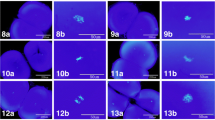Abstract
Heat shock has been used to inhibit cleavage for the induction of monogenic diploids or tetraploid in animals, but usually the success rate is low. Heat-shocked rainbow trout Oncorhynchus mykiss embryos were used in this histological study to clarify the causes of this low success rate. Embyros treated with hydrostatic pressure were used for comparison. After heat shock had disorganized the spindles, polypolar (tripolar or tetrapolar) spindles in addition to bipolar spindles were often reassembled soon after treatment. The embryos then completed tripolar or tetrapolar division at the first mitosis, and directly turned into three- or four-cell embryos as a result of the first cleavage. During the second mitosis, a monopolar spindle was formed in each blastomere of four-cell embryos and approximately 60% of three-cell embryos. In the remaining three-cell embryos, two of the three blastomeres formed a monopolar spindle, and the third one formed a bipolar spindle. The formation of polypoles is assumed to be caused by insufficient disorganization of daughter centrioles and splitting from the mother centriole by heat shock. Polypolar division is considered to be the cause of aneuploidy and the low success rate of chromosome set doubling. In the case of hydrostatic pressure treatment, the regenerated spindles were bipolar in almost all embryos.
Similar content being viewed by others
References
Streisinger G, Walker C, Dower N, Knauber D, Singer F. Production of clones of homozygous diploid zebra fish Brachydanio rerio. Nature 1981; 291: 293–296.
Naruse K, Ijiri K, Shima A, Egami N. The production of cloned fish in the medaka Oryzias latipes. J. Exp. Zool. 1985; 236: 335–341.
Thorgaard GH, Jazwin ME, Stier AR. Polyploidy induced by heat shock in Rainbow trout. Trans. Am. Fish. Soc. 1981; 110: 546–550.
Chourrout D. Pressure-induced retention of second polar body and suppression of first cleavage in rainbow trout: production of all-triploids, all-tetraploids, and heterozygous and homozygous diploid gynogenetics. Aquaculture 1984; 36: 111–126.
Nam YK, Choi GC, Park DJ, Kim DS. Survival and growth of induced tetraploid mud loach. Aquaculture Int. 2001; 9: 61–71.
Yamaki M, Satou M, Satou H, Kon Y, Zhang Q, Uchimura Y. Induction of tetraploid amago salmon by hydrostatic pressure and heat shocks and its verification by the maximum number of nucleoli and DNA contents. Fish Genet. Breed. Sci. 1997; 25: 37–48.
Zhang X, Mutsukawa K, Onozato H. Correlation between delay in earlier cleavage stage and tetraploidization rate in the rainbow trout Oncorhynchus mykiss embryos treated with heat or hydrostatic pressure shock during the first cell cycle. Fish. Sci. 2005; 71: 239–241.
Zhang X, Onozato H. Allo-eudiploidy of the diploid cells in diploid-tetraploid mosaic hybrids between female rainbow trout Oncorhynchus mykiss and male amago salmon O rhodurus. Fish. Sci. 2004; 70: 924–926.
Tahara H, Hosoe A. Triploidization of rainbow trout embryos obtained out of spawning season. Naganoken Suisan Shikenjo Jigyo Hokoku 1988; 1.
Onozato H. Diploidization of gynogenetically activated salmonid eggs using hydrostatic pressure. Aquaculture 1984; 43: 91–97.
Zhang X, Onozato H. Hydrostatic pressure treatment during the first mitosis does not suppress the first cleavage but the second one. Aquaculture 2004; 240: 101–113.
Ueno K. Autopolyploid. In: Suzuki R (ed.), Chromosome Manipulation and its Application for Aquaculture. Kosseisyakoseikaku, Tokyo. 1989; 70–81.
Mazia D, Harris PJ, Bibring T. The multiplicity of the mitotic centers and the time-course of their duplication and separation. J. Biophys. Biochem. Cytol. 1960; 7: 1–20.
O’Connell KF. The ZYG-I kinase, a mitotic and meiotic regulator of centriole replication. Oncogene 2002; 21: 6201–6208.
Okuda M. The role of nucleophosmin in centrosome duplication. Oncogene 2002; 21: 6170–6174.
Matsumoto K, Ohta T. Mitosis of rotenone-induced endoreduplication in Chinese hamster cells. Jpn. J. Genet. 1993; 68: 185–194.
Fujiwara A, Abe S, Yamaha E, Yamazaki F, Yoshida MC. Uniparental chromosome elimination in the early embryogenesis of the inviable salmonid hybrids between masu salmon female and rainbow trout male. Chromosoma 1997; 106: 44–52.
Rousselet A, Euteneuer U, Bordes N, Ruiz T, Hui Bon Hua G, Bornens M. Structural and functional effects of hydrostatic pressure on centrosomes from vertebrate cells. Cell Motil. Cytoskeleton 2001; 48: 262–276.
Arai K. Induced allotriploidy and allotetraploidy between female chum salmon and male Japanese charr by heat shock. Fish Genet. Breed. Sci. 1992; 18: 65–72.
Goudie CA, Simco BA, Davis KB, Liu Q. Production of gynogenetic and polyploid catfish by pressure-induced chromosome set manipulation. Aquaculture 1995; 133: 185–198.
Author information
Authors and Affiliations
Corresponding author
Rights and permissions
About this article
Cite this article
Zhang, X., Asami, T. & Onozato, H. Polypolar spindle formation during first cell cycle in rainbow trout Oncorhynchus mykiss embryos after heat-shock treatment. Fish Sci 73, 1325–1331 (2007). https://doi.org/10.1111/j.1444-2906.2007.01471.x
Received:
Accepted:
Issue Date:
DOI: https://doi.org/10.1111/j.1444-2906.2007.01471.x




